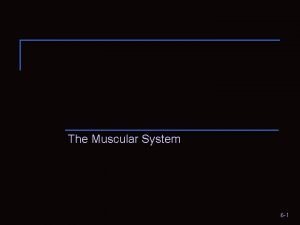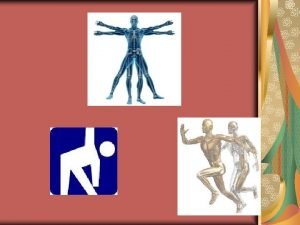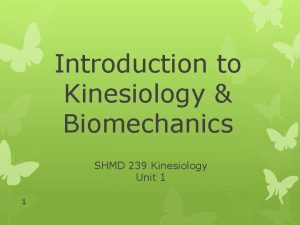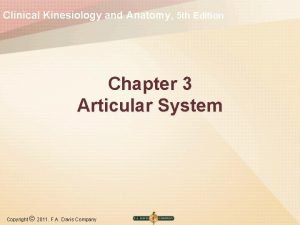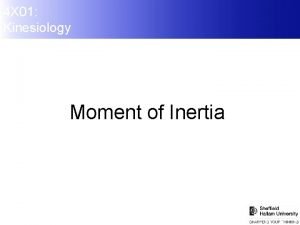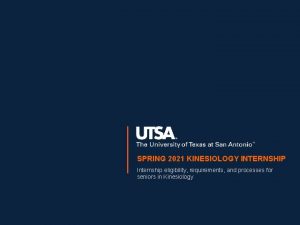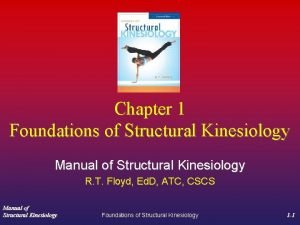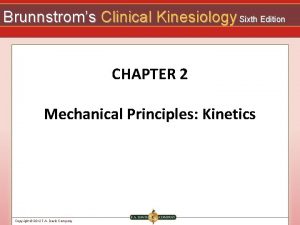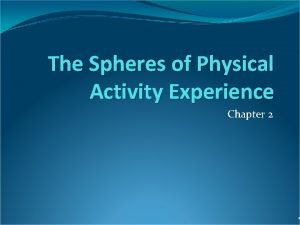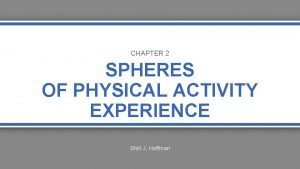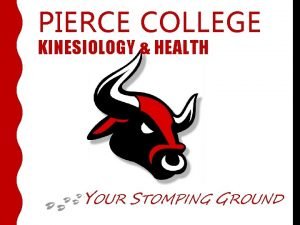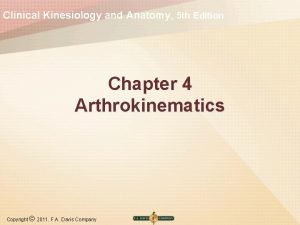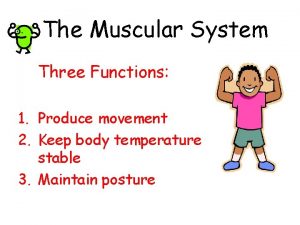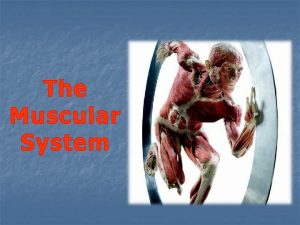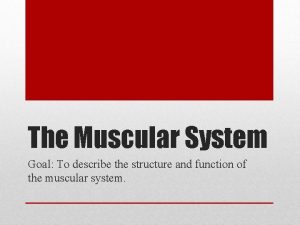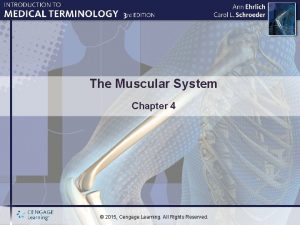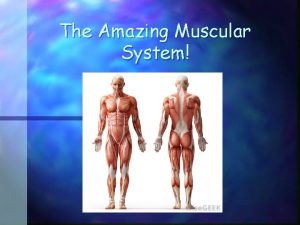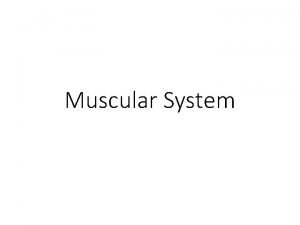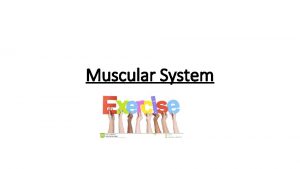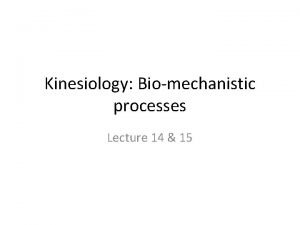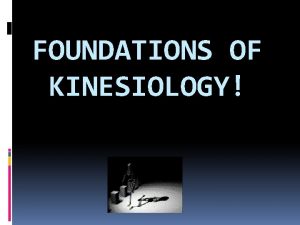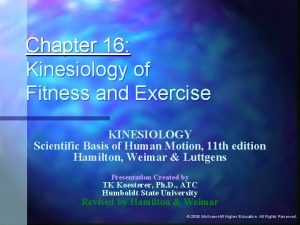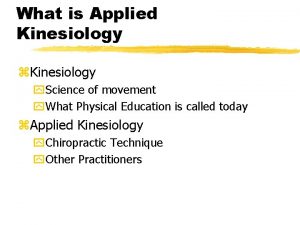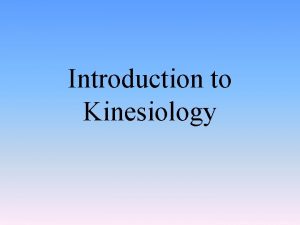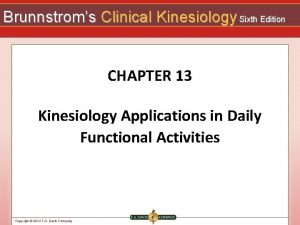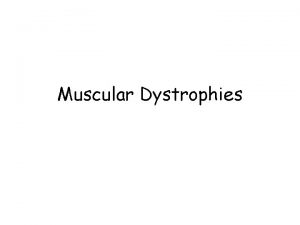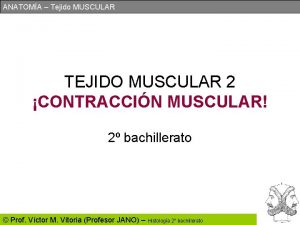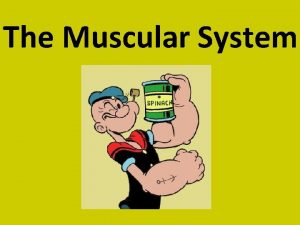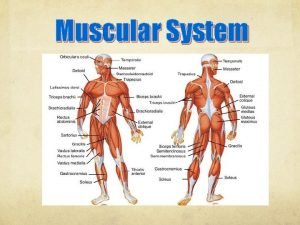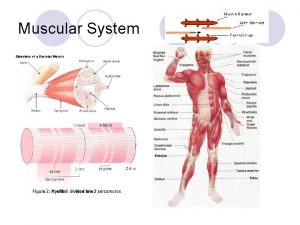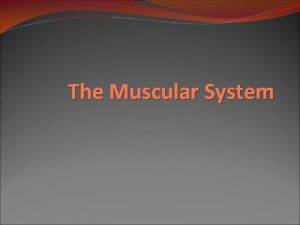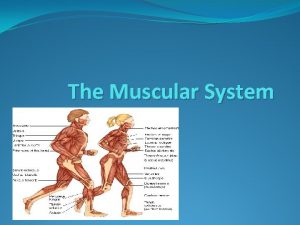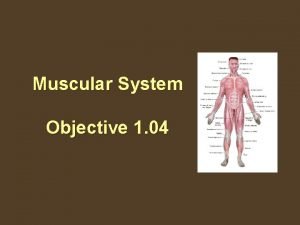THE MUSCULAR SYSTEM Kinesiology Unit 10 1 THE





























- Slides: 29

THE MUSCULAR SYSTEM Kinesiology Unit 10 1

THE MUSC ULAR SYS TEM Bones And Joints Provide The Framework Of The Body. However, Functional Muscular Tissue Is Necessary For The Body To Reach Its Movement Potential 2

The Muscular System 3

CHARACTER ISTICS The characteristics of muscle tissue enable it to perform some important functions, including: § Movement – both voluntary & involuntary § Maintaining posture § Supporting soft tissues within body cavities § Guarding entrances & exits of the body § Maintaining body temperature 4

PROPERTIE S Each Muscle Fibre Has Four Distinct Properties: § Irritability: Muscle Has The Capability Of Receiving And Responding To Various Stimuli § Contractility: When A Stimuli Is Received The Muscle Has The Capability Of Shortening § Extensibility: Able To Lengthen – Passive Or Active § Elasticity: The Ability To Return To Normal Resting Length Or Shape 5

MUSCLE The distinguishing characteristic of muscle is its ability to actively shorten and produce tension.

CHARAC TERISTI CS Types Of Muscular Tissue: § Skeletal Muscle: Attached To Skeletal. Striped Muscle. Voluntary Muscle • Associated with & attached to the skeleton • Under our conscious (voluntary) control • Microscopically the tissue appears striated • Cells are long, cylindrical & multinucleate 7

CHARACT ERISTICS Types Of Muscular Tissue: § Smooth Muscle: Involuntary Muscle Regulated By Autonomic Nervous System • • Makes up walls of organs & blood vessels Tissue is non-striated & involuntary Cells are short, spindle-shaped & have a single nucleus Tissue is extremely extensible, while still retaining ability to contract 8

CHARACTE RISTICS Types Of Muscular Tissue: § Cardiac Muscle: Heart. Controlled By Autonomic Nervous System. Consists Of Individual Cells • Makes up myocardium of heart • Unconsciously (involuntarily) controlled • Microscopically appears striated • Cells are short, branching & have a single nucleus 9

MUSCLE STRUCTURE NUCLEI FIBERS SARCOPLASMA IN CELL MEMBRANE CALLED THE SARCOLEMMA A COUPLE OF LONG STRAIGHT CYLINDERS MUSCLE 10

Muscle Structure 11

Anatomy of skeletal muscles epimysium tendon perimysium Muscle Fascicle Surrounded by perimysium Skeletal muscle Surrounded by epimysium endomysium Skeletal muscle fiber (cell) Surrounded by endomysium

MUSCLE TONE - State of continuous partial contractions (maintains posture) Hypertrophy - muscle enlargement - occurs with use of muscle Atrophy - muscle size, tone, and power decrease - occurs with lack of use - injury

MUSCLE STRUCTUR E Two Types Of Muscle Fibers: § Fast-twitch (White) Fibers § High Glycolytic § Low Oxidative § High Myofibrillar Atp-ase § Example: Sprinter § Slow-twitch (Red) Fibers § Low Glycolytic § High Oxidative § Low Myofibrillar Atp-ase § Example: Marathon Runner 14

MUSCLE STRUCT URE Fiber Arrangement And Direction § Longitudinal Muscle: When All The Fibers And Groups Of Fibers Within A Muscle Are Parallel With Log Axis Of The Muscle. Example: Sartorius And Rectus Abdominus § Fusiform Muscle: If The Muscle Fibers Are In The Form Of A Spindle. Example: Biceps Brachii § Radiate Muscle: If The Fibers Fan Out From A Single Attachment. Example: Gluteus Medius And Minimus And Pectoralis Major And Minor 15

MUSCL E STRU CTURE § Penniform Muscles: When The Group Of Fibers Within A Muscle Are Attached To The Side Of A Tendon That Runs The Length Of The Muscle, A Featherlike Appearance. There Are Three Types Of These Muscles: § Unipennate Muscles – Origin From A Large Area Of Bone And Run Obliquely To A Single Tendon § Bipennate Muscles – Obliques Fibers Are Attached To Both Borders Of Central Tendon § Multipennate Muscles – Combination Of Several Bipennate Muscles 16

ATTACHMENTS § Fasciae: Membranous Sheaths That Enclose Structures Of The Body § Superficial Fasciae: Immediately Beneath The Skin And Covers The Entire Body § Deep Fasciae: Series Of Dense, Membranous Sheaths That Vary In Shape, Size And Strength Depending On Their Function § Intramuscular Septa: Fascial Sheaths Between Muscles 17

MUSCULA R CONTR ACTION §Motor Units: Consists Of A Number Of Fibres Each Innervated Separately By A Nerve Branch From A Motor Neuron §Motor Neuron Provides Stimuli 18

TYPES OF MUSCULA R CONTR ACTION Isometric Contraction: No Joint Movement. Muscle Tension Is Equal To Resistance Isotonic Contraction: Joint Movement. Tension Causes Muscle To Move. Muscle Shortens Eccentric Contraction: Joint Movement. Gravity Causes Muscle To Move. Muscle Lengthens Isokinetic Exercise: Refers To Specific Isotonic Exercise In Which Angular Velocity At A Joint Is Kept Constant Through Range Of Contraction 19

ISOMETRIC CONTRACTION Produces no movement Used in § Standing § Sitting § Posture

ISOTONIC CONTRACTION Produces movement Used in § Walking § Moving any part of the body

EFFECTS OF EXERCISE ON MUSCLES Aerobic (endurance) - results in stronger, more flexible muscles, with a high resistance to fatigue - will not produce large size change ex. jogging, biking Anaerobic - results in larger, stronger muscles with little resistance to fatigue (occurs within 2 minutes of start of activity) ex. 50 meter sprint, competitive weight lifting

Anatomy of the Muscular System • Origin Muscle attachment that remains fixed • Insertion Muscle attachment that moves • Action What joint movement a muscle produces i. e. flexion, extension, abduction, etc.

• For muscles to create a movement, they can only pull, not push • Muscles in the body rarely work alone, & are usually arranged in groups surrounding a joint • A muscle that contracts to create the desired action is known as an agonist or prime mover • A muscle that helps the agonist is a synergist • A muscle that opposes the action of the agonist, therefore undoing the desired action is an antagonist

COOPER ATIVE A CTION O F MUSC LES Movers – Responsible For Performing Movement Antagonists – Opposite Muscle To Joint Of Muscle That Is Prime Mover Stabilizers – Stabilizing The Movers So They Can Work Effectively Synergists – Increase The Efficiency Of Prime Movers By Preventing Inhibiting Movements While Movement Is Being Performed 25

ELBOW JOINT The best known example of antagonistic muscles are the bicep & triceps muscles



END OF UNIT 29
 Differentiate muscular strength from muscular endurance
Differentiate muscular strength from muscular endurance Unit 6:5 muscular system
Unit 6:5 muscular system First year seminar
First year seminar Example of fixation in kinesiology
Example of fixation in kinesiology Biomechanics kinesiology definition
Biomechanics kinesiology definition Degrees of freedom kinesiology
Degrees of freedom kinesiology Repeat
Repeat Kinesiology ucf catalog
Kinesiology ucf catalog Holistic kinesiology definition
Holistic kinesiology definition Utsa kinesiology internship
Utsa kinesiology internship Canadian kinesiology alliance
Canadian kinesiology alliance Angular motion kinesiology
Angular motion kinesiology Manual of structural kinesiology 18th edition
Manual of structural kinesiology 18th edition Brunnstrom's clinical kinesiology 6th edition
Brunnstrom's clinical kinesiology 6th edition Sphere of physical activity
Sphere of physical activity Sphere of self sufficiency
Sphere of self sufficiency Pierce college kinesiology
Pierce college kinesiology Half standing derived position
Half standing derived position Stc kinesiology
Stc kinesiology Canadian kinesiology alliance
Canadian kinesiology alliance Clinical kinesiology and anatomy 6th edition
Clinical kinesiology and anatomy 6th edition Fitness chapter 15
Fitness chapter 15 Unit 10, unit 10 review tests, unit 10 general test
Unit 10, unit 10 review tests, unit 10 general test Three functions of muscular system
Three functions of muscular system Which is a primary function of the muscular system
Which is a primary function of the muscular system 4 function of muscular system
4 function of muscular system Chapter 4 the muscular system learning exercises answer key
Chapter 4 the muscular system learning exercises answer key Simple muscular system diagram
Simple muscular system diagram Muscle in latin language
Muscle in latin language Muscular system label
Muscular system label

